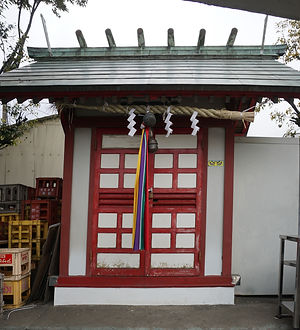普通の外にいくつかの著名な品質を持っている、と畏敬の念を起こさせるあるいかなるビーイングは、カミと呼ばれています。
Nearest station
Tenkūbashi
Keihin Kyūko Line
Tōkyō-to, Ōta-ku, Haneda 6-13-8
東京都大田区羽田6-13-8
玉川弁財天神社
Tamagawa Benzaiten Jinja
Home page: (Japanese)
February 23, 2018
Enshrined Kami:
Main
Mizuha-no-me-no-mikoto (32) 水波之咩命
From Merged Shrines
None
In-ground Shrines:
None
Earliest mention of:
Annual Festival: January 11, May 11
History
This site houses two shrines of equal importance, Tamagawa Benzaiten Jinja and Sui Jinja (水神社). The enshrined deity is Mizuha-no-me-no-mikoto, the goddess of wells. Despite this, it is nevertheless one of the Seven Haneda Fuku Inari, although it is not given a formal position within the Seven; if it were, the Seven would become Eight. Note that Sui-Kami (水神), The Water Kami, is usually seen as the masculine equivalent of Mizuha-no-me-no-mikoto, and that Benzaiten is the goddess of, among many other things, water.
The site was once occupied solely by Haneda Sui Jinja and was for a long time an important centre of worship for fishermen plying their trade in the nearby River Tama (Tamagawa). It is still registered as a religious corporation under the Sui Jinja name, which is therefore its formal name, although it is more commonly referred to as Tamagawa Benzaiten.
Its origin is unclear, but from olden times there seems to have been a Benten-sha in the area. Ryūō-in, (龍王院) a temple now located at Haneda 2-26-11, acted as its bettō-ji and referred to it
(Click on images to expand them)







as Jō-Gū: this shrine’s shintai was a replica of a figurine of Benzaiten said to have been crafted in 830 by Kūkai from hardened ashes from burnt incense sticks. When new rice paddies were being developed in Yōjima, an area in what is now Haneda Airport, a corresponding Ge-Gū was built and was named Benten-sha. In 1945, when GHQ requisitioned the airport, this Benten-sha was moved to what is now the Tamagawa Benzaiten Jinja.



